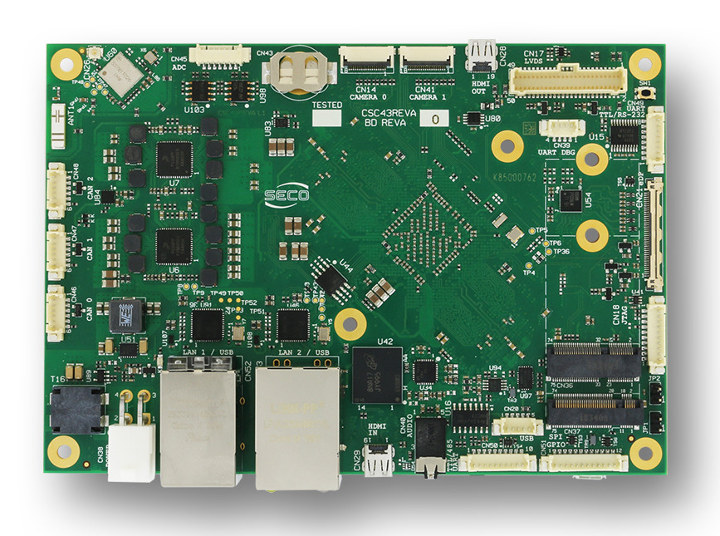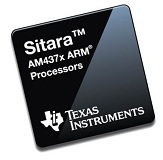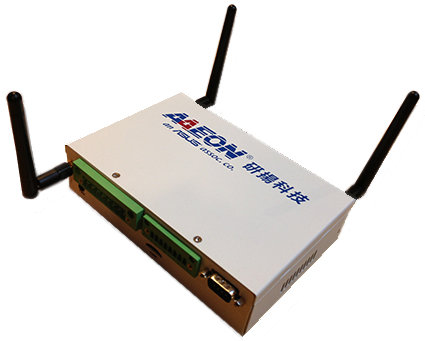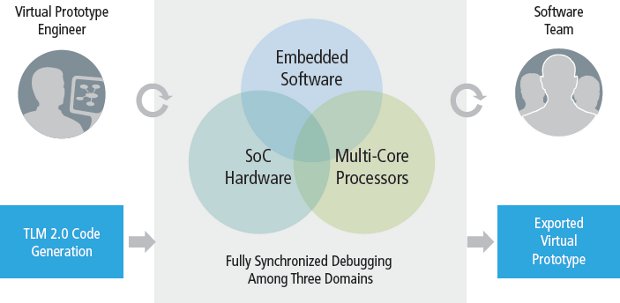When NXP unveiled their first 64-bit i.MX processors in 2016, we had three families: i.MX 8 Cortex-A72/A53 for high performance, i.MX 8M Cortex-A53 for audio/video application, and i.MX 8X Cortex-A53 for low power applications. Most of the designs we’ve seen so far are based on i.MX 8M family, and we’ve seen few hardware platforms based on the top of the line i.MX 8 QuadMax SoC with two Arm Cortex-A72 cores, four Cortex-A53 cores, two Cortex-M4F real-time cores, and two GC7000XS/VX GPUs. We did cover several modules based on i.MX 8 QuadMax processor including Advantech ROM-7720 Qseven 2.1 Computer-on-Module, Toradex Apalis i.MX 8 CoM, and Congatec conga-SMX8 SMARC 2.0 SoM among others, but AFAICR I had yet to see an i.MX 8 QuadMax single board computer. So Seco SBC-C43 appears to be the first SBC powered by NXP’s most powerful i.MX 8 processor, coupled with up to 8GB DDR4, 32GB eMMC […]
Wind River Introduces Free Cloud-based Operating Systems for IoT Applications
After Google Brillo operating system was officially launched last week, another company has announced free operating systems for IoT. What’s peculiar is that the company is Wind River a vendor of commercial operating systems whose typical business model is to sell licenses for their operating systems and fees for their development services. Nevertheless, the company has now introduced Wind River Rocket real-time operating system, and Wind River Pulsar Linux operating system. Both OSes will interface with the company’s Helix Cloud software-as-a-service (SaaS) products, which is probably how the company intends to monetize their work, on top of customization services. Wind River Helix App Cloud is currently made of three products: Helix App Cloud cloud-based development environment for building IoT applications Helix Lab Cloud cloud-based virtual hardware lab for simulating and testing IoT devices and complex systems. Helix Device Cloud cloud-based platform for managing deployed IoT devices and their data. Some […]
Texas Instruments Announces Sitara AM437x Cortex A9 SoCs and Evaluation Modules
The first time I heard about Texas Instruments Sitara AM437x was via a TechNexion EDM-CT-AM437x system-on-module back in 2012, but Texas Instruments Sitara Cortex A9 processors development seems to have dragged a little longer than expected. Nevertheless, the company has now formally announced their Sitara AM437x ARM Cortex A9 SoC targeting automation, IoT gateways, and other industrial applications, and featuring four PRUs (Programmable Real-time Units), and support for dual camera for terminals with bar code scanning. At launch there will be four AM437xprocessors: AM4376, AM4377, AM4378, and AM4379. The processors will all be based on a single Cortex A9 core @ 800 to 1000 MHz with 64KB SRAM shared with 32KB data cache and 32KB programmable cache, 256 KB L2 and L3 caches, a 32-bit memory interface supporting LPDDR2, DDR3, and DDR3L, a 2-port Gigabit Ethernet switch , two USB 2.0 OTG + PHY and the following other interfaces: Serial Ports […]
Aaeon AIOT-X1000 Linux Gateway is Powered by an Intel Quark SoC
Intel Quark SoC for low power embedded devices has been seen on platforms designed by Intel themselves, such as Intel Galileo board or Edison wearable development kit, but I had not found Quark SoC in actual products until Aaeon announced their AIOT-X1000 gateway for the internet of things running Linux on an Intel Quark X1000 SoC, and working with a Cloud Service by Asus, Aaeon’s parent company. The solution targets manufacturing, transportation, and energy applications. Aaeon AIOT-X1000 specifications: Processor – Intel Quark X1000-series SoCs @ up to 400 MHz System Memory – 1GB DDR3 800/1066 SODIMM Storage – IDE port, and micro SD slot Connectivity – 10/100M Ethernet USB 4x USB2.0 ports Serial – 1x RS-232/422/485, 1x RS-422/485 Other I/Os — I2C, GPIO, JTAG Mini-PCIe card expansion – 1x full-size and 1x half-size, allowing for WiFi, 2G/3G/LTE cellular, Bluetooth, CAN bus, ZigBee, and RFID add-on boards Power – 5V or 9-24V DC input Dimensions – 146 x […]
Xilinx Zynq-7000 Extensible Processing Platform (EPP): Dual Cortex A9 + FPGA SoC
The Xilinx Zynq-7000 EPP (Extensible Processing Platform) is a new class of device, offering a mix of a dual-core ARM Cortex-A9 subsystem (including cache, memory controllers, interface, and peripheral functions) with a 28-nm programmable digital FPGA and programmable analog capabilities. This combination opens the door to a range of demanding applications, including automotive (video processing and analytics requirements for driver assistance systems), broadcast (high-bit-rate bandwidth for high-accuracy video processing and analytics), and industrial control systems that combine high-processing demands with tight integration requirements. There are actually 4 models which share the same processing subsystem (CPU core, memory, peripherals, etc…) and only differ by the programmable logic used: Z-7010 – Artix-7 FPGA with 28K logic cells. Z-7020 – Artix-7 FPGA with 85K logic cells. Z-7030 – Kintex-7 FPGA with 125K logic cells. Z-7045 – Kintex-7 FPGA with 350K logic cells. The Zynq-7000 EPP platform allows concurrent software and hardware development: System […]
Virtual Hardware Platforms: Test & Debug Software Before the Silicon is Ready
Historically software could only be tested and debugged when the first silicon sample was ready, and the software team could not participate in the design process. But thanks to Virtual Hardware Platforms, software can be executed at speeds close to real time on an abstract model of the hardware, available long before a design has been completed. The virtual platform is designed to simplify the creation and support of virtual prototypes and allow design teams to begin developing software weeks to months before a hardware prototype is available, and software teams can use it as their application development platform. For example, Freescale is using a Virtual Hardware Platform for their new Vybrid Controllers to emulate both Cortex A5 and Cortex M4 cores, as well as peripherals and run OS such as Linux or MQX before the Controllers are ready (Q2 2012). One Virtual Hardware Platform has just won the ACE […]
The Power of SPDX (Software Package Data Exchange) – ELC 2012
Mark Gisi, Sr. Manager of Intellectual Property at Wind River , discusses SPDX (Software Package Data Exchange) at Embedded Linux Conference 2012. Abstract: Sharing Critical Licensing Information within a Linux Device Supply Chain Embedded Linux device runtimes are derived from 100s of open source packages. A common misunderstanding is that just one or two licenses govern a given open source package, when in fact; often a dozen or more apply. Therefore a device runtime could be under 100s of unique licenses. Determining which licenses are relevant is challenging. SPDX, the Linux Foundation’s license exchange format, provides an effective mechanism for recording and sharing licensing information within a device vendor supply chain. We present an overview of SPDX along with a detailed source code example on how to create and extract relevant licensing information. The target audience includes developers, engineering managers, release operation engineers and license compliance professionals. They will learn […]
Wind River Unveils Android User Experience, Connectivity and Medical Modules.
Wind River has introduced Wind River Solution Accelerators for Android, a series of software modules to help developers jumpstart their Android development and rapidly integrate compelling features and functionalities to their devices. Wind River Solution Accelerators for Android are currently available in three software modules: User Experience: Accelerated boot time technologies including Hyper boot enabling devices to resume from RAM in less than 1 second and from Flash in 8 seconds. This technology can speed up the Android boot time by 30%. It is hardware agnostic and can run on different hardware platforms with little or no customization effort. Multi-windowing screen navigation aimed at devices with larger screens such as tablets, automotive infotainment systems, media phones, and industrial devices. The application windows are sized based on the remaining portion of the visible screen and users can minimize, resize, and arrange them as they wish. (See Picture on top) Media Center […]










